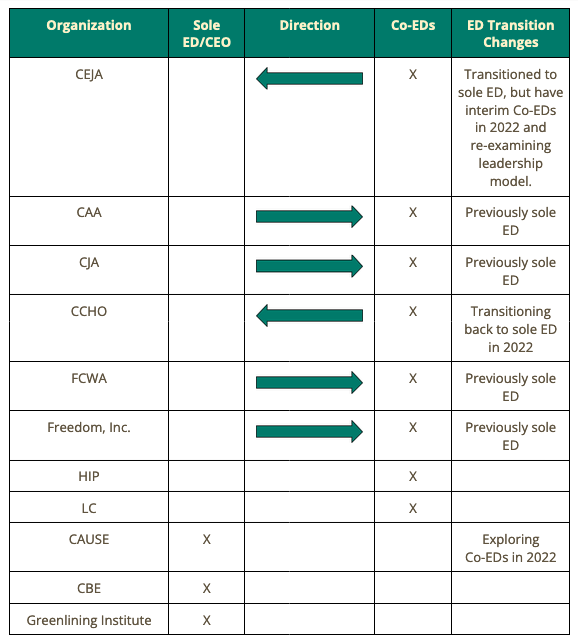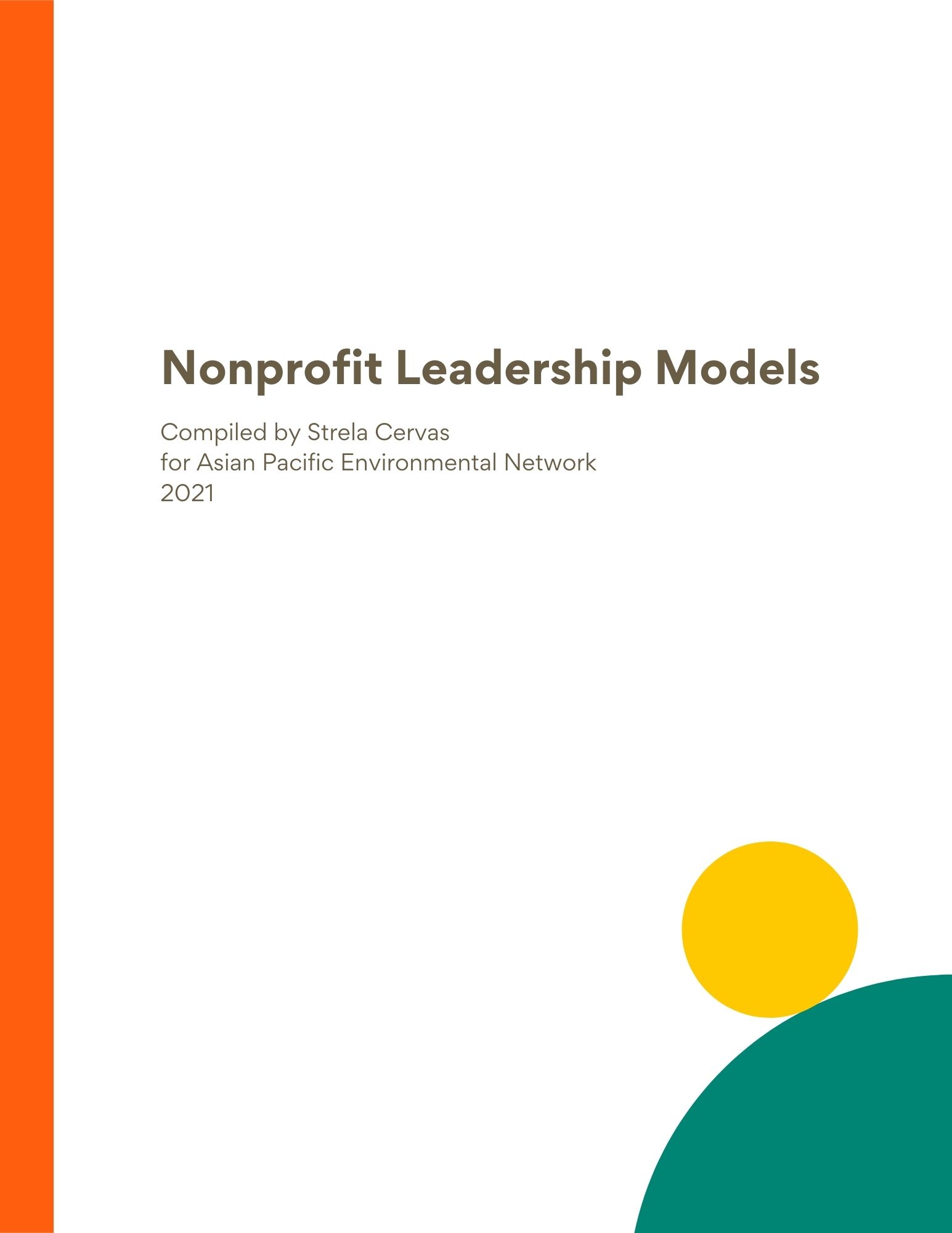In every change there is opportunity.
In 2021, Miya Yoshitani, Executive Director of Asian Pacific Environmental Network, announced that she would be transitioning out of her role as E.D. As we celebrated Miya’s leadership, we took this opportunity to consider moving from a sole-Executive Director leadership model to a structure in which two Co-Directors work together to lead our organizational strategy, power building and campaigns.
To inform our decision-making process, APEN hired Strela Cervas, longtime ally and former Co-Director of California Environmental Justice Alliance, to conduct research on the two leadership models: sole Executive Director and Co-Directors.
We wanted to understand what these two leadership models looked like in practice for movement organizations, and the benefits and challenges of each. What structures and practices are needed for organizations to thrive under each of these models?
APEN was born as a movement organization and has been held, supported, and encouraged by our broader community at each step. Especially in times of change and transition, we are deeply grateful for the insights and wisdom of our peers.
Strela conducted 1-on-1 interviews with Executive Directors and Co-Directors from 11 movement organizations: 8 of which currently have Co-Directors, and 3 which have a sole Executive Director / President & CEO.
Each organization shared their core values, structure, and culture as context for understanding their leadership models. In addition to identifying the challenges and benefits of their leadership models, organizations also shared how they make decisions, and for groups with Co-Directors, which roles and responsibilities each Co-Director holds.
We hope that our research will be helpful for other groups that are considering similar questions as they navigate change and transition.
Key Takeaways
The main benefits/reasons for a Co-Director model:
- Shared leadership and valuing leadership: Organizations that choose a Co-Director model feel that their core values of shared leadership and democratic decision-making are better reflected in a Co-Director model.
- Complementary skill sets: Organizations with a Co-Director model report an unfairness in the expectation that a single person should be knowledgeable in all the skill sets that are required of leadership.
- Sustainability: Organizations that transitioned from a sole ED model to a Co-Director model report that their role as a sole ED can be extremely unsustainable. They believe that a Co-Director model relieves some of the burden.
- Challenge to white dominant culture and capitalism: Several organizations want to disrupt the dominant system of one charismatic leader.
- Productivity: Co-Directors that transitioned from a sole ED model report a bottleneck in tasks. They believe that Co-Directors are able to accomplish more.
- Challenge to white dominant culture and capitalism: Disrupt dominant system of one charismatic leader.
- Productivity: Sole EDs report a bottleneck in tasks. Co-Directors get twice as much done.
- Identity: Leadership should reflect those you serve and organize. Co-Directors with varying identities achieve that.
Overall benefits/reasons for a sole ED/CEO model:
- People-centered approach: One major determinant of hiring the next leader of an organization is the people. All EDs interviewed cited the importance of succession plans and two of the three organizations hired from within the organization.
- Clear accountability: The organization is clear that the ED/CEO is largely responsible for oversight, fundraising, hiring and firing, and board coordination.
- Clarity of supervision and coordination with the next “tier” of staff: The Deputy Director and/or director-level staff are clear that they have one supervisor and can directly coordinate and communicate with the ED/CEO.
- Main contact for the organization: In most cases and especially for high profile situations, the general public is clear who is the main contact and spokesperson for the organization. Funders and policy-makers also appreciate one main contact for an organization.
- Ability to also have shared leadership: Organizations with a sole ED/CEO model say they do, in fact, have shared leadership and that decision-making can be distributed. For example, one organization uses a “transformative organizing model” where decisions are distributed across the organization.
The main challenges and pitfalls:
Co-Directors Model:
- Lack of alignment: Vision, values, and/or politics are misaligned, or not on the same page about major decisions.
- Lack of communication: Co-Directors often report needing to communicate on a daily basis on any number of issues. A Co-Directorship fails when there is a lack of communication.
- Inequitable roles: A challenge to a Co-Directorship is when roles and responsibilities do not feel fair or equitable where one Co-Director may feel responsible for too many areas of work compared to the other Co-Director.
- Unequal comfortability in power dynamics: Both Co-Directors need to feel equally empowered to be the ultimate decision-makers. However, problems arise if one Co-Director is less comfortable making decisions.
- Staff deference to Co-Directors: Some organizations report staff deferring to Co-Directors on all decisions, despite Co-Directors empowering staff to make more decisions within their purview.
- Potential to side with- and form alliances with one Co-Director: Staff may have their “favorite” Co-Director and always go to that Co-Director to favor their opinions. To avoid alliances, Co-Directors must always be united.
Sole Executive Directors/CEO Model:
- Sustainability: Some EDs interviewed report a potential lack of capacity to do it all. One ED said, “It’s a lot. It’s way too much work.”
- Expectations too high: Some EDs report an expectation that the ED needs to be an expert at everything from fundraising to HR to programs to operations. One ED said they “had a huge job description” where requirements ranged from executive skills to strong “heart-centered” internal management skills.
- Easily get scrutinized: One ED said that since the ED is the ultimate decision-maker and the face of the organization, they can be easily blamed for every action or decision that is not aligned with others’ perspectives (compared to other models with shared leadership).
- Potential to be less collaborative: One ED shared an experience of not consulting staff or community when making a major decision and the community called for their accountability.
Across the Board (for both Co-Directors and sole EDs):
- Decision-making: There is an underlying assumption that decision-making would be more confusing with a Co-Director model. However, even sole EDs reported that decision-making is challenging for their organizations.
- Capacity: Even with any type of organizational restructuring many report that the overall job is still unsustainable.
- Bias against female executive leadership: Organizations report challenges of what it means to have female and non-binary executive leadership, especially women of color. Unseen “women’s work” (behind-the-scenes or administrative work) is not valued.
- Challenge of being a cohesive team for larger organizations. Lack of centralized direction and oversight.
There is no one formula for how Co-Directors divide their roles.
Some organizations believe in sharing all of the major responsibilities equally, while others have a “lead”. There is no one way for determining who will be the lead. In general, organizations report divvying up the responsibilities according to: 1) Skill set/expertise, 2) Interest, 3) Relationships, 4) Capacity available, and 5) Identity (race, gender, sexuality, etc).
Best practices across leadership models:
- Distributed leadership: Across both sole ED and Co-Director models, there are some roles (e.g. fund development or spokesperson) that can be distributed to other staff.
- Collaborative and supportive leadership teams: Both sole EDs and Co-Directors do not have to carry the full burden. All organizations tend to use a tiered model to support their leadership: 1st tier of EDs/Co-Directors and 2nd tier of Program/Project Directors.
- Staff empowered decision-making: Across both sole ED and Co-Director models, organizations use a “Transformative organizing model” or “Lateral leadership” where directors, organizers, and even members are empowered to make decisions.
List of Co-Directors and Executive Directors Interviewed
APEN and Strela Cervas (consultant) deeply appreciate the following people who generously participated in the interviews and shared their wisdom to make this valuable research possible.
Co-Directors
- California Environmental Justice Alliance (CEJA), Strela Cervas, former Co-Director (Feedback/opinions as former Co-Director. Organization transitioned to sole ED at time of research)
- Chinese for Affirmative Action (CAA), Vincent Pan, Co-Director
- Climate Justice Alliance (CJA), Marion Gee, Incoming Co-Director (Organization transitioning to Co-Directors at time of research)
- Council of Community Housing Organizations (CCHO), Fernando Martí, Co-Director
- Freedom, Inc., Kabzuag Vaj, Co-Executive Director
- Food Chain Workers Alliance (FCWA), Joann Lo, former Co-Director
- Human Impact Partners (HIP), Solange Gould, Co-Director
- Leadership Counsel for Justice and Accountability (LC), Veronica Garibay and Phoebe Seaton, Co-Directors
Sole Executive Directors / President & CEOs
- Central Coast Alliance United for a Sustainable Economy (CAUSE), Maricela Morales, Executive Director (exploring Co-Director model for the future)
- Communities for a Better Environment (CBE), Darryl Molina Sarmiento, Executive Director
- Greenlining Institute, Debra Gore-Mann, President & CEO
The table below shows the changes in the leadership model. The “X” indicates the status (sole EDs/CEO or Co-EDs) at the time of the interview between March to April 2021. The arrow indicates the direction in which the leadership model changed/is changing: from sole ED/CEO to Co-EDs or from Co-EDs to sole ED/CEO.



